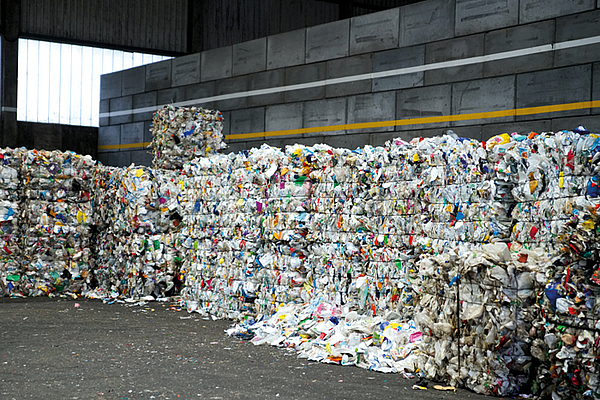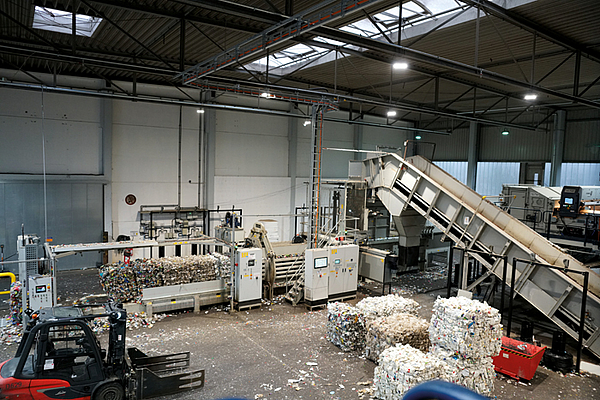Is there anything technical you would like to see solved?
Mandelatz: Absolutely. Even more consistent implementation of the Design for Recycling model, worldwide. And for Germany a steering effect with the plastic tax. At the moment it is more of a fiscal instrument. If the state collects the money, it should also have a steering effect that promotes the circular economy. In our view, simply levying taxes on plastic placed on the market is not the right approach.
Lehmann: In our view, a good example is the UK model, where recycled content is taken into account. In the UK, plastic products with less than 30% recycled content currently cost around £210 per tonne. Obviously, a tax targeted in this way helps to make recycled plastic more competitive with virgin plastic.
_______________
''First of all, I would like to see a rapid and rigorous implementation of the Single-Use Plastic Directive and a consistent implementation of the Packaging and Packaging Waste Regulation with the corresponding control mechanisms - across Europe.'' - Ralf Mandelatz
_______________
Mandelatz: At the beginning of 2022, we acquired the reverse vending business from Diebold Nixdorf, so we already have intelligent reverse vending technology at the point of sale. The idea behind RE DEPOSIT is to know at an early stage what packaging is being thrown into the collection container. This would give us better control over what arrives at our sorting facilities and what needs to be sorted.
Since 1 January, plastic packaging for milk and milk-based drinks has also been subject to a mandatory deposit in Germany. Milk packaging enters the material stream via the collection machines. Does this affect sorting?
Mandelatz: Until then, we had a very pure PET material stream through the deposit system. The introduction of PS, PP or even PET milk packaging presents us with challenges. Yes, we have noticed that many dairies have now switched to PET. These are often transparent bottles. This is positive in itself, but to protect the product, these bottles have a full-body sleeve. This makes optical sorting more difficult. PETG labels are also not helpful in the process. At best, both result in a lower yield. A clear bottle under a sleeve may be lost to the material cycle and end up in other applications, such as fibre. That wouldn’t be ideal, even if we were to give this plastic a second life.
Do the white coloured bottles and those with barrier material also interfere with the sorting process?
Mandelatz: It would be helpful if marketers would declare the packaging design so we could see what the packaging is made of. As it is, we have to do a lot of analysis to find out. If there are transparent multilayer bottles in the fraction that we cannot detect, these bottles fly into the colour fraction. They don’t bother us there, but it’s a shame because the aim is to keep as much as possible in the transparent stream.
How do you determine the quality of your recyclates?
Mandelatz: I would like to explain the complex requirements using PP as an example: The cosmetics and detergents industry prefers to package their products in PP. In cosmetics, we differentiate between packaging for products that stay on the skin longer - creams, for example. These are called “leave-on products”. There are different requirements for this packaging than for packaging for cosmetics that are only in contact with our skin for a few seconds, such as shower gel, known as “rinse off” products. The proportion of permitted substances in the packaging depends on the use of the packaging. We have our recyclates tested for migration in each batch by an external laboratory. Currently only RE Plano carries out this process. This is how we ensure the conformity of our recyclates.
This is a complex process.
Mandelatz: The entire certification process takes about three to six months. This means that the materials are stored until they are approved. Inhouse testing plus testing by external laboratories - this is what we do for smaller customers. It is a fascinating field for us. But there are also - mostly larger - customers who carry out the analyses themselves. Brands don’t just work with a single packaging manufacturer to test the specific packaging with our recycled material. This means that we first send samples to the brand manufacturer, then the samples go to the packaging manufacturers. They analyse them again and do their tests on the packaging. The whole process takes a long time and is not comparable to what we know from the PET sector. This lead time is the investment we have to make in working capital if we want to be listed as a supplier. It’s just as demanding as in the automotive industry.
So sorting is more than just sorting.
Mandelatz: It is important that we know as much as possible about our input material so that we can assess the impact of specific packaging in the material flow on the end product. The more complex this information, the higher the quality of our recycled products.
In the end, are you actually a material manufacturer?
Mandelatz: That is actually very close. The big difference is that when you produce virgin material, you have very homogeneous input material. But we have extremely heterogeneous input material. The heterogeneous input material makes our material production more challenging.
Thank you very much for this interview.
www.replano.com www.remondis-recycling.de









